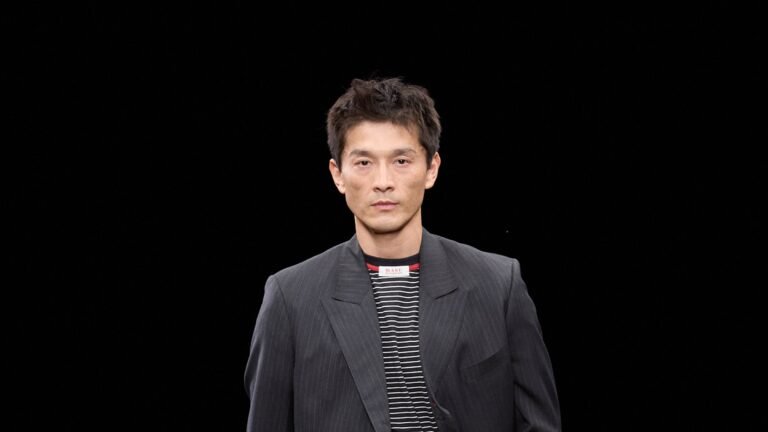What happens when a brand stages a fashion presentation not for the press and buyers but for its fans? On a sweaty June evening, Masu’s Shinpei Goto did just that. The tiniest handful of editors were invited to the designer’s spring presentation at a warehouse in Tokyo Bay, along with more than 300 Masu Boys, the nickname that the brand’s fans—of all ages and genders—have adopted. These well-dressed fans, more than a few of them students from Bunka Fashion College (Goto’s alma mater), were mostly clad in Masu staples—spiky popcorn tops, rhinestoned denim, distressed baseball caps—as they queued up excitedly in the balmy twilight.
Inside the space lay the felled tree trunk of a 200-year-old Yamanashi cedar, which served as the runway. (Goto had asked a furniture-maker friend to source it for him; it will later be made into a table.) The idea was to show guests the inner workings of how Masu put this season’s look book together, in the place it had been shot just hours earlier. The crowd, supping cans of beer and whiskey highballs, gathered around the timber runway as the crew dressed the models and called out directives like “Walk a little faster!” or “Next model, please!” over the speakers. It was a look-book shoot as a meta performance and Goto’s way of bringing his fans into his world. “Even if young people get to see fashion shows, they don’t often get to know about the world behind it,” he said.
His theme this season was “in the raw,” a rebellion against the boring bog of algorithms and corporate priorities that fashion creatives are mired in. “Everything these days has become about numbers, not about whether it’s cool or not,” said Goto. “I think that’s really creepy and no fun.” His idea manifested in intentionally loose threads, frayed edges, and unfinished embroidery and in the labels that were sewn on both sides of striped shirts. “I thought that it would be good if the person who wears it decides which way it goes,” he said. “There is no right answer.”
Beyond a rebellious flavor, Masu has a distinct note of anachronism. The designer can take menswear references from seemingly disparate eras—Ivy League or Victoriana—and mash them together into something fresh and convincing for the moment. This time he printed a photograph of the yellowing, tattered lining of an antique jacket onto sheer mesh fabric, which was itself layered over a T-shirt. He made fringed jodhpurs into baggy trousers and transformed MA1 bombers into faded gilets decorated with numerous buttons. Most innovative of all were jeans and hoodies held together with cable ties, which will be sold deconstructed with an instruction manual detailing how to assemble them. A bit like IKEA? “Yeah, exactly!” Goto grinned.
Midway through the presentation, the designer got up on the wooden runway, working the crowd like an emcee and handing out Masu items to the audience; their tickets had each been printed with a raffle prize number. The effect was of an authentic gathering of like-minded individuals with stars in their eyes, marveling at how the Masu magic happens. It was also a show of community that most brands would kill for.


